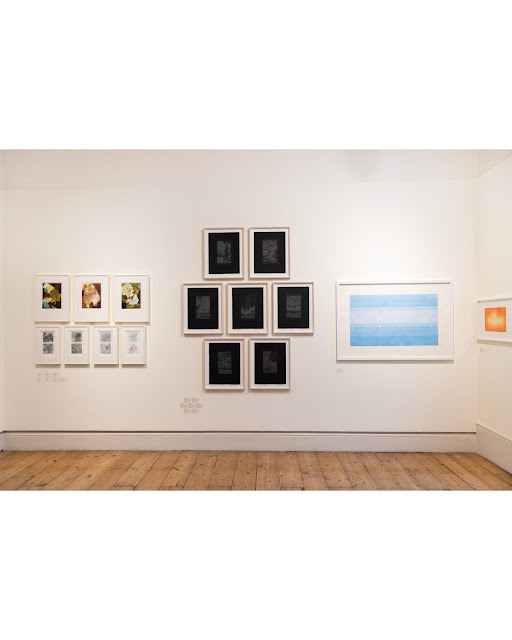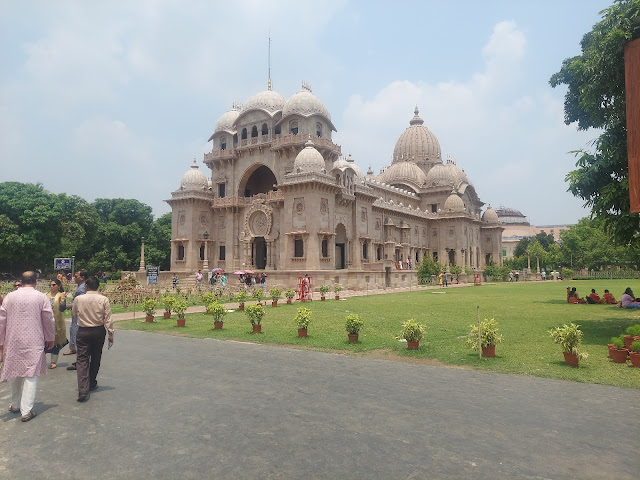dagagiri
my blog is my archive
Sunday, July 06, 2025
Tuesday, June 17, 2025
Monday, May 19, 2025
Artful Mergings: Print and Place / London Original Print Fair 2025
by Anuj Daga
April 25, 2025
Artful Mergings: Print and Place
Anuj Daga
(How) do traces of one’s roots find their way in one’s artistic work? This is the question that prompted India Printmaker House to bring together a group of seven artists at the London Original Print Fair 2025 from India and the UK Indian diaspora. The tightly curated show featuring prints by artist Shivangi Ladha, Ian Malhotra, Mahima Kapoor, Avni Bansal, Rewati Shahani, Saruha Kilaru, and Jaimini Jariwala at the Somerset House between 20-23 March 2025 opened up a host of means and methods through which questions of identity, belonging and memory of cultural past may be gestured in artistic practice. In creating such a landscape, this exhibition not only foregrounded contemporary experiments in printmaking by young artists but also strategized a channel for cross-border connections and collaborative exchanges.
Born to a family that fled from Pakistan to Mumbai during partition, Rewati Shahani continued to live in London after studying Fine Art at the Central St. Martins. She expresses the shift in her own space-time coordinates in her minimalist screen prints that impress translucent maplike cut out forms on solid rectangular opaque bases. At once, these appear like irregular stones placed on a planar surface. In overlapping these, she mixes up their characteristic values of the heavy and light, organic and geometric, natural and manmade, alluding the sedimented geography of a location to leak into a distant ephemerality of the horizon. In counter positioning the land and the sea thus, her works ask if horizons are mere imaginary datums or places may find their real geographies ever? In doing so, the work begins to speak of the location of culture as it moves through bodies and borders.
London-based artist Ian Malhotra plays with the real and
virtual in his ‘Monday-Sunday’ series where he etches videogame midnight skies
onto paper. He explains, ‘[q]uite a lot of open world video games have diurnal
cycles for realism, so the light and weather changes throughout the day as the
character walks through the landscape…When the game's diurnal cycle arrived at
exactly midnight, I took a picture of this sky.’ Referencing these frames in
his sketches, Malhotra makes his canvas black, converting it into a digital
screen, further marking white luminous lines to render the cloudy skies. The
folding of the past over the present occurs in Malhotra’s works at multiple
registers. The mass circulating virtual images are etched exactly in the manner
of the imaginary landscapes etched by noted Western artists, eventually
reproduced by print for mass consumption - highlighting the fundamental
space-time dichotomy of engaging with images. Moreover, the endlessness of the
sky and the screen - the two infinities that have united humanity historically
as well as in contemporary times - find a common ground in Malhotra’s canvas.
Mixing of forms occurs through the deployment of
transparency in Saruha Kilaru’s non-figurative prints on a variety
of surfaces such as glass, ceramics, fabrics, sequins and paper. Kilaru
carries forward the aesthetics of watercolour renderings in print, wherein
colour-forms get defined by material textures. Her works invite us to enjoy the
shapes that liquids take in resisting external forces, in turn acting like a
stretched elastic membrane themselves due to the cohesive forces between fluid
particles. The glimmering surfaces of Kilaru’s prints attract the viewer's
attention to the constant slippage between light and colour, animating surface
tension as impressionistic work of art itself.
Mahima Kapoor’s prints allude to magnified images of
environmental contamination as seen under a microscope. Strains of entropic
bodies - those that appear foreign to each other - coexist within a single
frame in her artworks. Her series ‘A Place of Oasis’ seems to be a snapshot of
polluted wasteland that holds organic and inorganic matter decaying together,
making us consider discordant colours and temporalities in simultaneity. In
making the viewer stare at these, Kapoor discomforts the onlooker while surfacing
the unwelcome chemistry of decomposition. She thus charts a map of pollution at
different scales, inducing an affectual response to the chemical, biological
and allergenic processes that are byproducts of human action.
Avni Bansal orchestrates the coming together of shapes into
indigenous mythical patterns in her ‘Phallic Series’. Celebrating the unison of
male and female sexes in her bilaterally symmetric block printed compositions,
Bansal depicts sexual interplay with splendour and adornment. Bansal seems to
expand the repertoire of ancient tantric symbols in her monochromatic crimson
red prints that tell a tale of biological transformation and spiritual
transcendence. In these compact prints, one observes a grammar of shape
fractals that hold the energy of life in an androgynous balance. As one looks
at her other prints, the orientalist gaze begins to dissolve into a more
rational one, reminding the imaging of the world in print by naturalists and
botanists when these very mythical forms begin to appear as cellular and
scientific.
The relationship between the self and the world is further
explored in the prints of Shivangi Ladha. Through an iterative process of
printmaking, Ladha overlaps multiple states of being, within which a female
body realises its existence within the world. Rigorously repeated sleepacts
soon transport the viewer into a dreamlike space of the subconscious, evoked in
the graded application of colour on or off the individually impressed bodies.
Should her works ‘LightWeaver’ or ‘Rise I’ be mounted vertically, they shall
begin to index the performative embodiment of her print practice itself.
Ladha’s prints demonstrate the everyday rhythms through which one reconciles
the inner self with the external reality. The viewer is invited to participate
in the process of collective awakening in Ladha’s artworks - one that shall
truly allow us to make the world one’s home.
Jaimini Jariwala explores the question of home through the materiality of fabric that she has been surrounded with since her childhood. The historic port town of Surat, where Jariwala grew up emerged as a major textile industrial hub after independence. By using the cyanotype and stitch on paper, the artist at once brings the warps and wefts of the textile to dialogue with the oceao-mercantile ecology of her place. The figure of the home is held in tension between land and sea, recalling the life of sea-farers along the coast of Surat for whom much life is lived on the sail. The semi solid, skeletal, amphibian homes normalise transient living in a world that itself is on the move.
The seven artists presented in this unique show have been brought together through the various programmes of the India Printmaker House, which is a platform dedicated to cultivating a vibrant art community united by a passion for printmaking. India Printmaker House (IPMH) believes in bridging cultures and expanding the global dialogue of art. The works presented by the IPMH at the LOPF 2025 have demonstrated a range of ways in which the question of place and belonging surfaces in the thinking and practice of the participating artists. Here, the medium of print begins to reveal the dualism of stabilization and destabilization, also reflective of the nature of lives that the artists who imagine homes within or outside borders constantly traverse, and effectually merge in their works of art.
***
Saturday, May 17, 2025
Saturday, May 10, 2025
on Monophobia / On Hobbies
Monday, March 24, 2025
Notes on Play - 2
Connected to Earlier Post
published in Hindustan Times, 24 March 2025
Link: https://www.hindustantimes.com/cities/mumbai-news/cultures-of-play-a-new-book-looks-at-how-children-play-in-the-city-101742756856410.html
includes my essay:
Locating Play Across the Inside / OutsideCase of Mumbai apartments from 1970-2020
Anuj Daga
This paper aims to trace the evolution in the cultures of play-spaces for children within the changing apartment living configurations of the middle class within the city of Mumbai over the last fifty years. The contention of the paper is to bring out the dialectic relationship between the forms of spaces and spaces of play that emerge in the densifying suburban residential neighbourhoods of Mumbai. In order to scope this study, I focus on three stages in typological forms of apartment configurations that have evolved in the city over 1970-2020, and the allied neighbourhood provisions to compensate for playspaces, that primarily come to characterise suburban living in Mumbai. These evolutions are reflective of the social, economic and political forces that shape urban development, and in effect the infrastructure of play as inscribed in the city.
Sunday, March 02, 2025
Waterfront Clubhouse, Abin Chaudhuri, Bansberia, West Bengal



















































